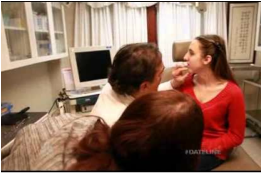
Writer. Sociologist. Teacher.
In early 2014, NBC’s Dateline aired an episode ostensibly examining the consequences of teen bullying, a social problem that has captured the public imagination for good reason. Public health research indicates that bullying carries mental and physical health consequences not only for the bullied but also for the bully. And sociological research demonstrates how adolescent bullying reproduces broader systems of inequality, including sexism, racism, classism, ableism, and queerphobia.
But something about this primetime examination of bullying was different.
After introducing several of the teens whose stories were chronicled over the course of the hour, Dateline correspondent Hoda Kotb set up the unique premise of the episode: “The teens say they’ve been pick on, laughed at, even physically harassed, and they all blame the bullying on one thing—their looks…So in an attempt to silence their bullies and rebuild their shattered self confidence, they’ve all decided on the same extreme course of action.”
What is this extreme course of action? Facial surgery. In other words, teens featured in the show were seeking surgical intervention with the hopes that a new appearance would curb bullying.
Facial surgery on children is not altogether unheard of. Most of us have seen the full-page newspaper or online sidebar ads featuring the work of Operation Smile or Smile Train. Both organizations conduct facial reconstructive surgery throughout the world, primarily to repair cleft lip and plate. The work of these organizations is largely celebrated. Given that these facial differences often impede basic functions like ingestion and even hearing, these interventions are taken for granted as necessary.
By contrast, the work of The Little Baby Face Foundation (LBFF), the organization featured in the Dateline episode, is more controversial. Comments featured on Dateline’s website reveal that some viewers see the work as a natural extension of Operation Smile and Smile Train’s efforts—as a needed intervention. Yet others suggest that surgically altering a teen’s appearance amounts to a medicalized victim blaming, wherein the subject of bullying is forced to change while the structural causes of bullying remain unaddressed.
Whether viewers support or oppose intervention largely hinges on some unanswered questions: Are the children in the Dateline episode disfigured? And how do we know?
The Dateline episode intrigued me. Since 2006, my work as a sociologist has focused on facial difference and surgical interventions on the human face. I have conducted ethnographic fieldwork with a face transplant team, interviewed Operation Smile volunteers, examined marketing presentations of facial feminization surgeons, and analyzed plastic surgery reality television. In Saving Face, the book that emerged from this research, I describe the ways in which some faces that are not immediately intelligible as “disfigured” are routinely constructed as such and then treated with subsequent interventions.
The fact that a face that many would perceive as unremarkable, normal, or average can be described and acted upon as “disfigured” points to the power of diagnosis to either amplify or moderate stigma. It is also true that this process of diagnosing disfigurement allows for certain facial interventions to be understood as reconstructive rather than cosmetic.
For viewers who were disturbed by the Dateline episode, what seemed unnerving is that the teens who were selected for surgery appeared rather unremarkable. In other words, most would not rate the teens’ appearances as attractive based on widely shared cultural norms of beauty, but presumably, neither would most rate the teens as “deformed.” Importantly, this is precisely how LBFF sees these teens’ faces.
As Dr. Thomas Romo, co-founder and president of LBFF, explains in the episode “There is a spectrum. Some are really profound and some are minimal, but there is still a facial birth abnormality.” The Dateline episode is a vivid portrayal of this spectrum at work. What is considered typical (albeit not desirable) in one context can be perceived and diagnosed disfigured in another.
Classic feminist analysis of disordered eating to new sociological work on cosmetic injectables point to the insidious consequences of beauty culture, including growing consumer debt, compromised mental and physical health, and rising inequality. But beauty culture is not the only lens through which we view and inhabit our bodies.
Ableism, the systematic devaluation of bodily difference, is at work too. What was once considered ugly is increasingly defined as disfigured, and perhaps more startlingly, what was once perceived as in the range of normal is increasingly diagnosed as abnormal. The Dateline episode is but one cultural moment that reveals how the stigma that disability carries is used to motivate and justify appearance related intervention.
While it is critical to pay attention to shifting norms of attractiveness, it is also critical that we observe how the spectrum of disfigurement shifts and evolves over time, and with what consequences. To paraphrase Dr. Romo, some faces are really typical and some are more distinct, but there is flexibility in diagnosing
 RSS Feed
RSS Feed
